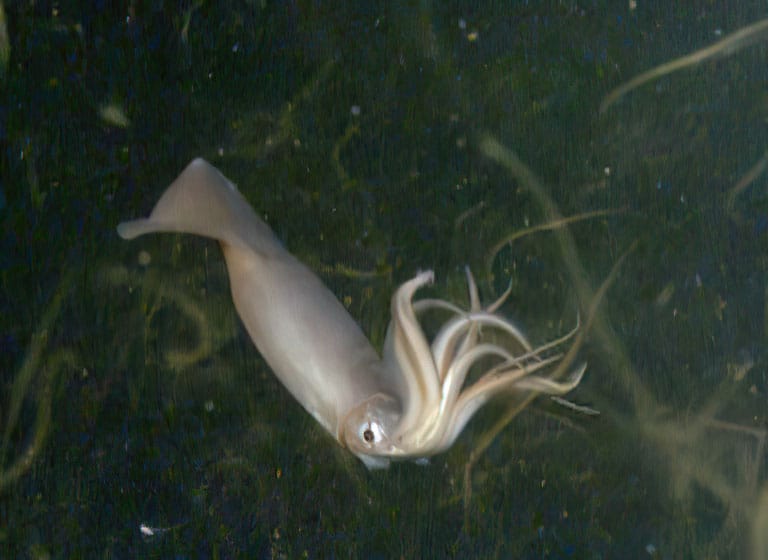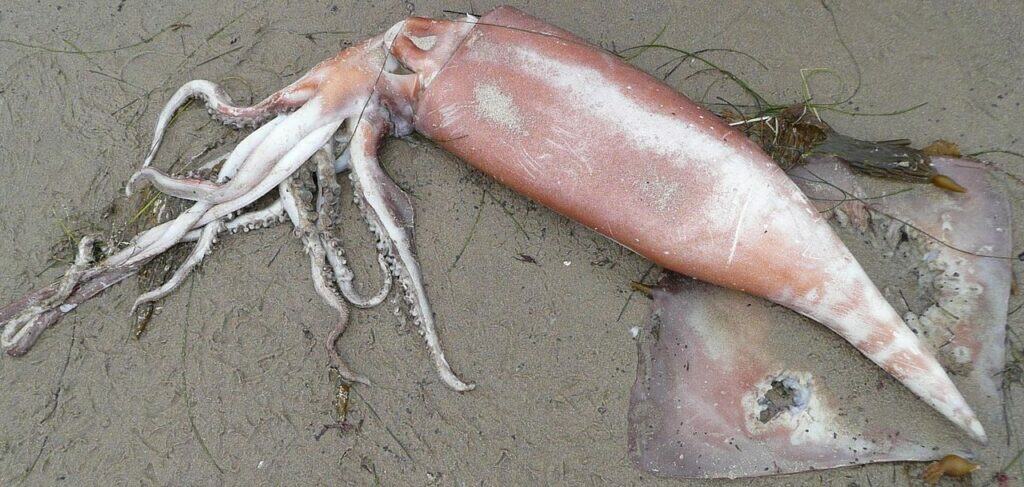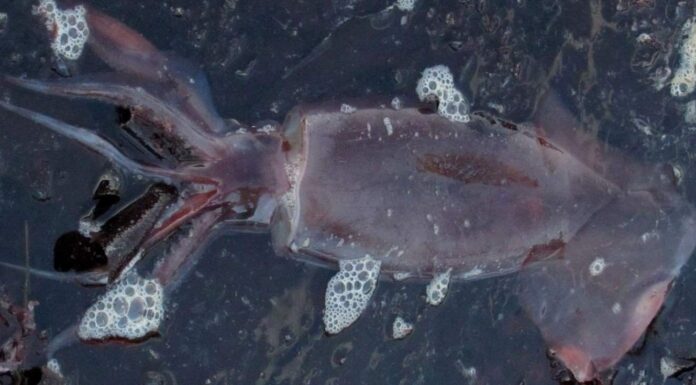The Humboldt squid, also commonly known as the jumbo squid, is a type of flying squid that cuts an imposing figure in the deep sea.
It is named after the Humboldt Current, which flows north along the coast of South America. The current was likewise named after the German naturalist and explorer Alexander von Humboldt. This species is a particularly popular component of seafood dishes around the world.
3 Incredible Humboldt Squid Facts!
- The Humboldt squid has the ability to change color from white to red and back again. This serves as both as a means to communicate with each other and as a warning to potential predators. It might also serve as a form of camouflage. These adaptations have earned it the nickname of red devil, because it flashes bright red when caught.
- The family name of flying squid comes from the fact that it can launch itself out of the water to avoid predators.
- This species can propel itself very quickly through the water by shooting a jet in the opposite direction it wants to go. The undulating fins help them navigate through the environment.
Humboldt Squid Classification and Scientific Name

Image courtesy of NOAA/MBARI 2006 / public domain – License
The scientific name of the Humboldt squid is Dosidicus gigas. Gigas means giant in Greek because it’s the largest member of the flying squid family. It is also the only currently living member of its genus.
Humboldt Squid Appearance
The Humboldt squid is one of the world’s larger cephalopods. The mantle alone (meaning the actual body) measures between 4 feet and 6.5 feet long, while the 10 barbed tentacles, each of which has 100 to 200 suckers, add another few feet to the length. Altogether, this species can reach a weight of approximately 110 pounds. The squid is characterized by a long, almost cone-shaped mantle with two wing-like fins emerging from the sides. The razor-sharp beak, which has an immense bite force, sits at the base of the mantle, where the 10 tentacles converge. As mentioned previously, the skin can transform colors depending on the mood.

Hmwith at English Wikipedia / public domain – License
Humboldt Squid Distribution, Population, and Habitat
The Humboldt squid inhabits the deep open recesses of the eastern Pacific Ocean, reaching depths of more than 2,000 feet. This species appears to move from deeper to shallower waters about once a day to feed. It may also migrate around the oceans in ways that aren’t currently understood. This species was historically concentrated between Mexico and Peru, but it has also begun to expand to locations as far as Alaska and Chile. Despite being well-studied, it is currently classified by the IUCN Red List as data deficient.
Humboldt Squid Predators and Prey
The Humboldt squid is a mid-level predator. They eat so much that they can sometimes exhaust fisheries in locations where they live. However, they must always be on the lookout for predators farther up the food chain.
What eats the Humboldt squid?
The Humboldt squid is a favorite food of large predators such as sperm whales, pilot whales, marlins, swordfishes, seals, sharks, and sometimes even birds. If threatened, this squid can shoot ink at predators as one of its many defensive adaptations. It can also make a quick getaway at impressive speeds and even leap out of the water.
What does the Humboldt squid eat?
The squid has a very diverse diet of small fish, crustaceans, and other cephalopods (squids and octopuses). It grabs the prey quickly with its tentacles and then tears the flesh or shell apart with the incredible bite force of its sharp beak.
Humboldt Squid Reproduction and Lifespan
Very little is known about the actual reproductive habits of the Humboldt squid. They seem to mate at such immense depths that the courtship display is rarely observed. It’s assumed that changing coloration plays a role in courtship by signaling sexual availability. Once a pair has agreed to mate, the male will transfer his sperm into the female’s mantle via one of his specialized tentacles. After fertilization has taken place, the female squid will produce a gelatinous mass of around a million eggs. Females may have multiple mating partners every year and lay up to 20 million eggs in their short lifespan.
Once the eggs hatch about a week later, these creatures are incredibly small and vulnerable. With minimal parental protection, many of them are preyed upon in this early stage. The juvenile will form large schools for protection. Fortunately, they begin to grow rapidly, reaching their full length in just under a year. By the time they are adults, the squids congregate together in smaller groups. Their lifespan normally ends after completing the first reproductive period.
Humboldt Squid in Fishing and Cooking
The Humboldt squid is the most popular commercially caught squid in the world. Many tons of squid are captured in Mexico every night by a technique called jigging, in which the line is jerked up and down to simulate prey. Both artisanal and industrial-scale fishing will catch immense numbers of squid and then sell them to markets all around the world.
Because of the ammonium chloride, which keeps the squid buoyant in the water, the flesh can naturally taste bitter or sour. That is why it is usually tenderized and washed to improve the taste first. Squid can be cooked and prepared in any number of different ways; frying and battering are particularly popular all over the world.
big, cone-shaped mantle, 10 barbed tentacles, and two fins on the sides.
Where are Humboldt squids found?
They’re found in the eastern Pacific.
How do Humboldt squid reproduce?
The squid reproduces via internal fertilization. Like many cephalopods, the male transfers his sperm into the female’s mantle via a specialized tentacle. Many cephalopod females have the ability to store sperm temporarily from multiple males and even choose which sperm to fertilize at a given moment. This is one of its most important reproductive adaptations.
Why is the Humboldt squid so dangerous?
While this squid does have a large body size, sharp beak, massive bite force, and aggressive temperament, they aren’t too dangerous. Injuries and attacks do occur, but fortunately not too often.
Do Humboldt squids attack humans?
Direct attacks on people are rare, but the evidence does suggest they react aggressively toward unfamiliar things, even cameras, and subs, perhaps because they feel threatened or annoyed or because they may just be protecting their food source. In the right circumstances, this squid isn’t dangerous at all. It has been known to act with curiosity and docility toward people.
What eats the Humboldt squid?
The Humboldt squid is preyed upon by sperm whales, pilot whales, marlins, swordfishes, seals, sharks, and sometimes even birds.
Why are Humboldt squid moving to cooler waters?
There are a few theories for why the squid has expanded into new locations. Perhaps it’s due to changing ocean conditions; an expansion of the low-oxygen “dead zone” in which the squid thrives. Or perhaps it’s due to a decline in competing predators.
